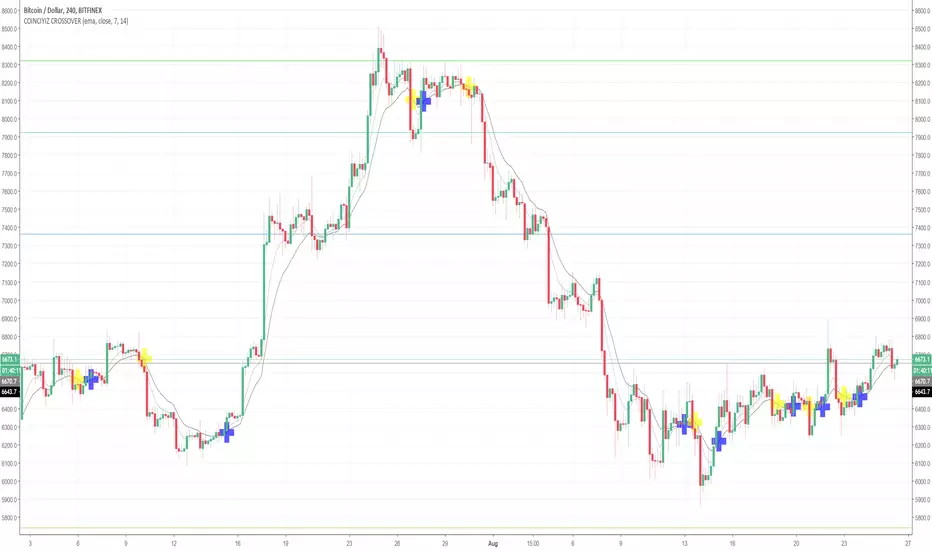PROTECTED SOURCE SCRIPT
COINCIYIZ CROSSOVER 1.1

A crossover is used by a technical analyst to forecast how a stock will perform in the near future. For most models, the crossover signals that it’s time to either buy or sell the underlying asset. Investors use crossovers along with other indicators to track things like turning points, price trends and money flow.
Crossovers indicating a moving average are generally the cause of breakouts and breakdowns. Moving averages can determine a change in the price trend based on the crossover. For example, a technique for trend reversal is using a five-period simple moving average along with a 9/21-period simple moving average. A crossover between the two will signal a reversal in trend, or a breakout or breakdown.
A breakout would be indicated by the five-period moving average crossing up through the 21-period. This is also indicative of an uptrend, which is made of higher highs and lows. A breakdown would be indicated by the five-period moving average crossing down through the 9/21-period. This is also indicative of a downtrend, composed of lower highs and lows.
Longer time frames result in stronger signals. For example, a daily chart carries more weight than a one-minute chart. Conversely, the shorter time frames give earlier indicators, but they are also susceptible to false signals as well.
(R: investopedia)
Short signal - Yellow
Long signal - Blue
Crossovers indicating a moving average are generally the cause of breakouts and breakdowns. Moving averages can determine a change in the price trend based on the crossover. For example, a technique for trend reversal is using a five-period simple moving average along with a 9/21-period simple moving average. A crossover between the two will signal a reversal in trend, or a breakout or breakdown.
A breakout would be indicated by the five-period moving average crossing up through the 21-period. This is also indicative of an uptrend, which is made of higher highs and lows. A breakdown would be indicated by the five-period moving average crossing down through the 9/21-period. This is also indicative of a downtrend, composed of lower highs and lows.
Longer time frames result in stronger signals. For example, a daily chart carries more weight than a one-minute chart. Conversely, the shorter time frames give earlier indicators, but they are also susceptible to false signals as well.
(R: investopedia)
Short signal - Yellow
Long signal - Blue
Skrip terproteksi
Skrip ini diterbitkan sebagai sumber tertutup. Namun, Anda dapat menggunakannya dengan bebas dan tanpa batasan apa pun – pelajari lebih lanjut di sini.
Pernyataan Penyangkalan
Informasi dan publikasi ini tidak dimaksudkan, dan bukan merupakan, saran atau rekomendasi keuangan, investasi, trading, atau jenis lainnya yang diberikan atau didukung oleh TradingView. Baca selengkapnya di Ketentuan Penggunaan.
Skrip terproteksi
Skrip ini diterbitkan sebagai sumber tertutup. Namun, Anda dapat menggunakannya dengan bebas dan tanpa batasan apa pun – pelajari lebih lanjut di sini.
Pernyataan Penyangkalan
Informasi dan publikasi ini tidak dimaksudkan, dan bukan merupakan, saran atau rekomendasi keuangan, investasi, trading, atau jenis lainnya yang diberikan atau didukung oleh TradingView. Baca selengkapnya di Ketentuan Penggunaan.